Text by Ashley Carnahan, Alice Gelber & Trevor Keyfauver
Photography by Hannu Kivimäki
Videography by Renee Whalen
For much of the Summer, the Avenue 26 Night Market in Lincoln Heights could be heard in the hiss of sizzling meats, smelled in rendered fat dripping off the trompa, tasted in handmade churros, and felt in the summer heat rising from the asphalt.
At its height, the market bustled with thousands of visitors while the sun shined and after it set, quickly becoming a place of connection for people emerging from isolation in search of collective outdoor experiences and good food.
It was a remarkable time for a long, bustling stretch of stands that, before Covid, was little more than a single popular taco stand — Avenue 26 Tacos.
But on Aug. 5, authorities shut down the booming market.
The story of the market’s rapid rise and its sudden disappearance says a great deal about entrepreneurial spirit in the face of hardship, as well as the ways scrappy underground businesses can thrive where there are few or no regulations. The market may have become so successful that it became overexposed, leading to its sudden closure.
Now, Artesian Street is empty, quiet. There are concrete barriers and fenced-off blacktop where boisterous crowds shopped, ate, and even rode a mechanical bull. The market was a rare and vibrant story of success in the pandemic, and a testament to some immigrants’ perseverance.
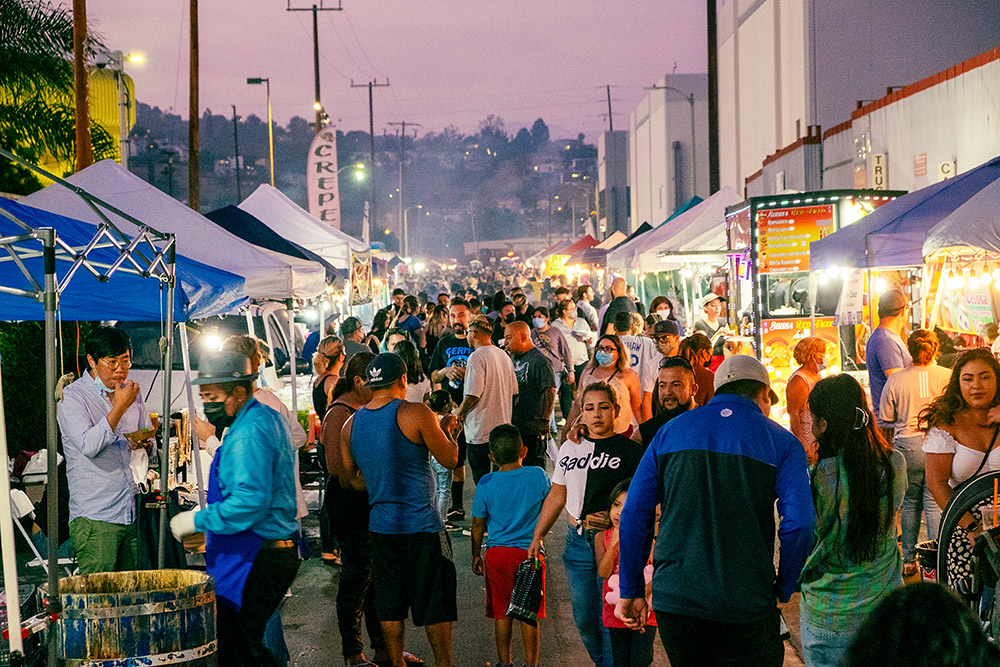
The Avenue 26 Night Market in Lincoln Heights was buzzing on this night two weeks before it was shut down.
A Rising Market
Avenue 26 Tacos, the night market’s namesake, had been the lone stand on Artesian Street for over 12 years. In 2013, a YouTube video exposed customers to the delights of the stand’s Puebla-style tacos, which mixes Mexican and Arabic traditions, which helped make it a local hot spot. Cesar Reyes, CEO of Avenue 26 Tacos, says the company expanded to food trucks and a brick-and-mortar restaurant over the years, but until 2020, its original taco stand was alone on Artesian Street.
Where is was L.A.'s hottest open air market?
The market wasn’t planned. It just emerged. The pandemic caused many workers to lose their jobs around the city. Aspiring vendors organically and independently showed up in the Artesian Street alley eager to launch small businesses during a pandemic that shut down so many that rented traditional office space, Reyes said. This created the unregulated, informal food vending market.
TikTok, YouTube, the Los Angeles Times and Eater took notice. Vendors saw an unprecedented rise in business and, as pandemic restrictions eased, tourists from Chicago, Miami, Utah and Arizona flocked to Los Angeles to get a glimpse of the trendy “night market.”
While Avenue 26 Tacos actually had to close their downtown restaurant, the original taco stand and the market’s popularity kept their business alive. For many vendors, the market’s success allowed them to pay bills and buy food.
The market began to draw crowds so large that local residents struggled to park within blocks of their homes. Music rose up from the streets, reaching houses where Angelenos were isolating in fear of a deadly virus.
COVID's Entrepreneurs
For Lesley Analco, 19, and her family, the Night Market was a saving grace. During the pandemic, vendors discovered a street where they could earn a reliable and growing source of income.
Most of the vendors at the market are immigrants, many undocumented, who live on the edge of the legal economy. Their entrepreneurial spirit should not be surprising, says Alvaro Huerta, Cal-State Pomona Professor of Urban and Regional Planning and Ethnic and Women’s Studies.
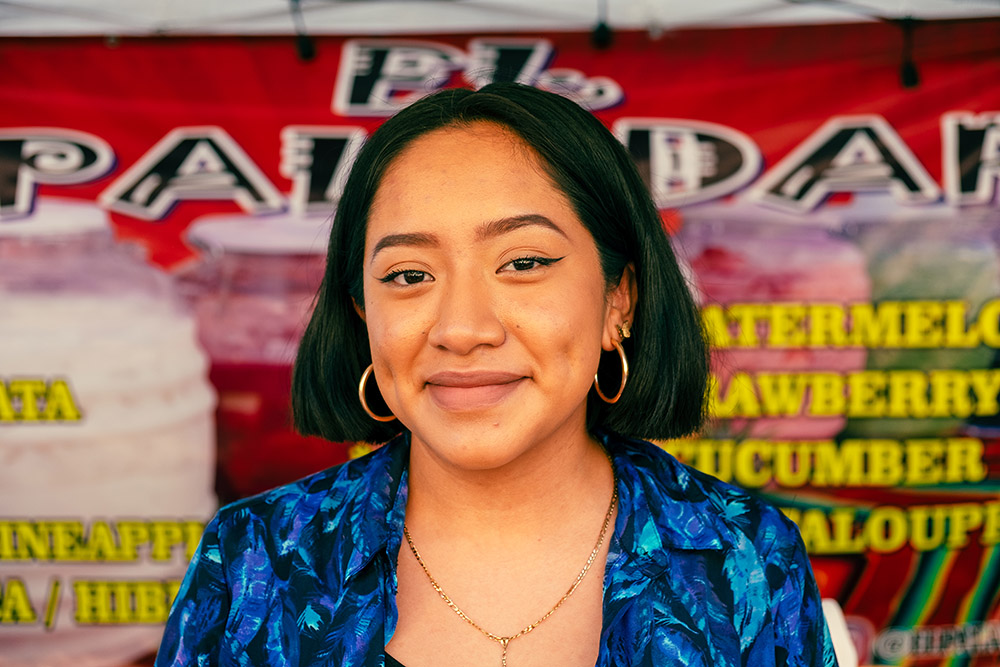
Lesley Analco works at her family's El Paladar taco and agua fresca stand. El Paladar opened in March 2020.
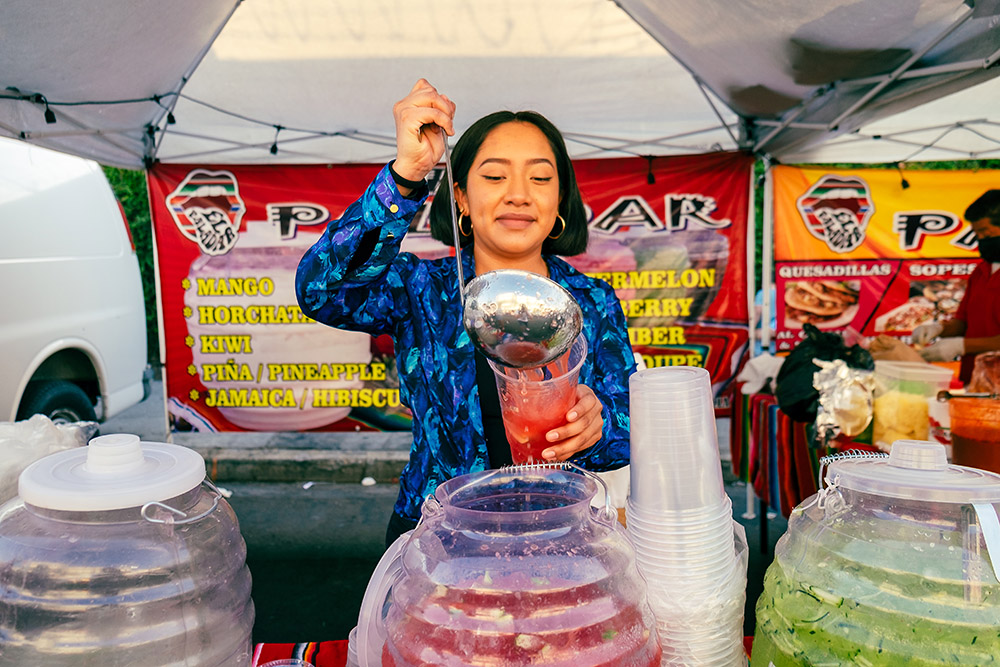
Analco serves a watermelon flavored agua fresca.

El Paladar's $5 horchatas sold briskly.
Immigrants are especially capable of adapting to challenging circumstances, like a global pandemic, says Huerta, because that is what many of them have been doing their entire lives.
We see immigrants as just workers, Huerta adds, but they are people. They bring food, culture and music.
That is part of why customers loved the market; it was full of stands that sold tasty international foods. There were drinks and music and community.
But legal food vending in Los Angeles requires permits for operation, and many street entrepreneurs did not have them. Some said they were unaware that such permits even existed. According to one vendor, only four of his colleagues on the street had the necessary permits.
Free Enterprise
Days before the Avenue 26 Night Market closed, Huerta said, the market could only exist informally — i.e., without permits. If the market became overly regulated, it would no longer have been cost-effective. Vendors would have had to pay for permits, rent, taxes and more, and they would have passed those costs on to customers.
“It doesn’t work to formalize it,” Huerta said. If the city did so, it would just be taking the street vendors’ money and punishing people that the economy has already pushed into the shadows.
But they still boosted the local economy, he said. While the market itself was informal, vendors purchased supplies, including ingredients like meat, from the formal and taxed economy. In July, Avenue 26 Tacos had to raise the price of a taco from $1.00 to $1.50 because the cost of ingredients and wages had risen — a 50 percent increase.
“The economy does really well if they [the city] have street vendors buying fruits, buying products, buying meat, buying everything we need,” Analco said. The ingredients were sourced from local, organic markets. Analco’s family bought fresh produce for their agua fresca stand every morning.
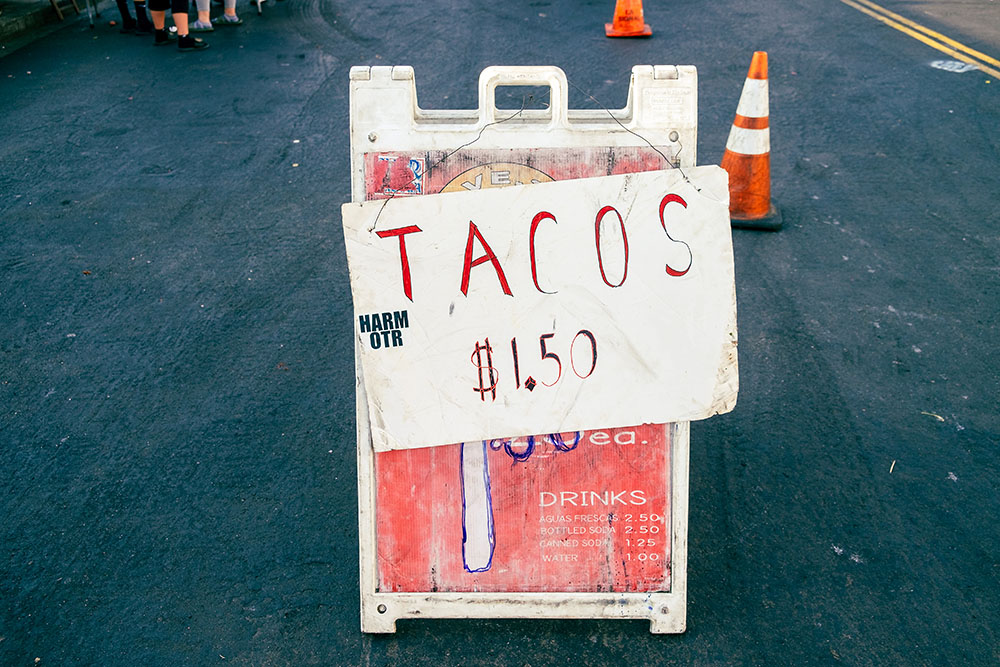
Avenue 26 Tacos had to raise the price of its taco from $1 to $1.50, citing the rising cost of food and labor.
In some ways, markets like this one help define the city. Huerta said that Los Angeles’ foodie identity isn’t just about big Michelin-star restaurants; it is about the small, spontaneous spots where people hustle to provide the best food.
From an economic standpoint, the market was “brilliant,” Huerta said, noting that each stand primarily sold one specialty, creating healthy competition among food vendors. To Huerta, the stands complemented each other as much as they competed for customer attention.
Overexposure
During the pandemic, the market was like a secret, but more and more people were in on it.
As it became more popular, there was always the chance that unwanted scrutiny would follow.
Reyes at Avenue 26 Taco believed that the city would close the stands without permits as soon as the pandemic waned. Some vendors at the market were already scouting out backup locations.
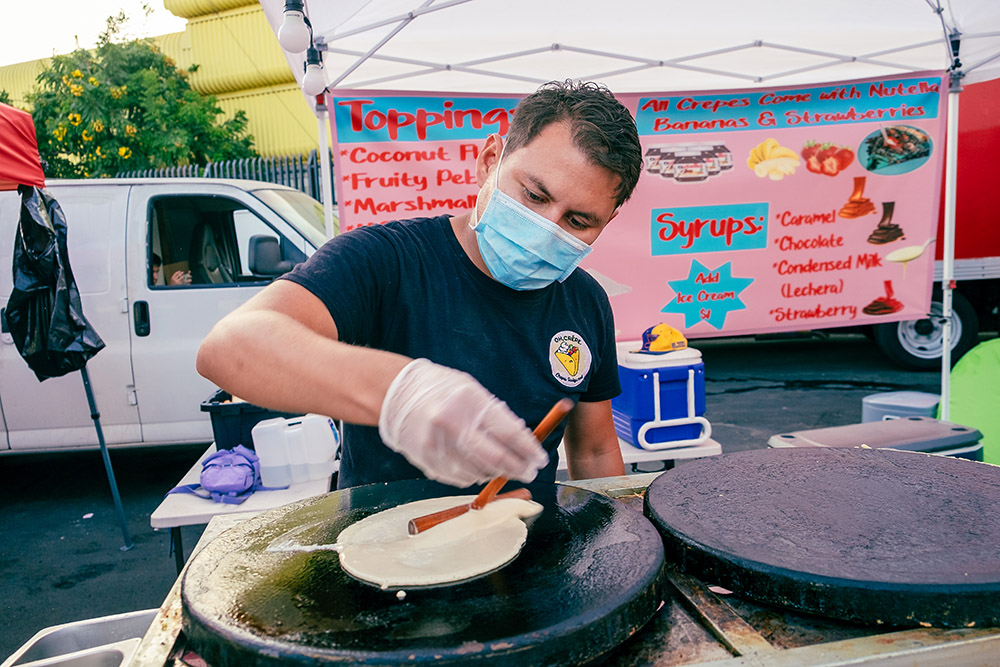
Darwin Hernandez of Crepes Hollywood was one of the few permited vendors.
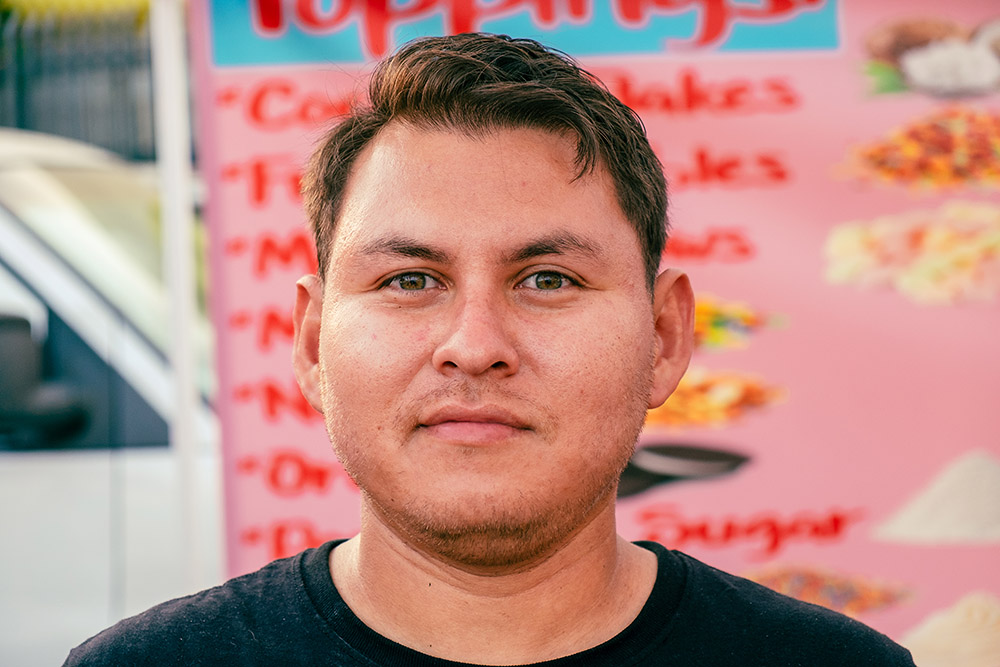
He moved his crepe stand to the market in January.
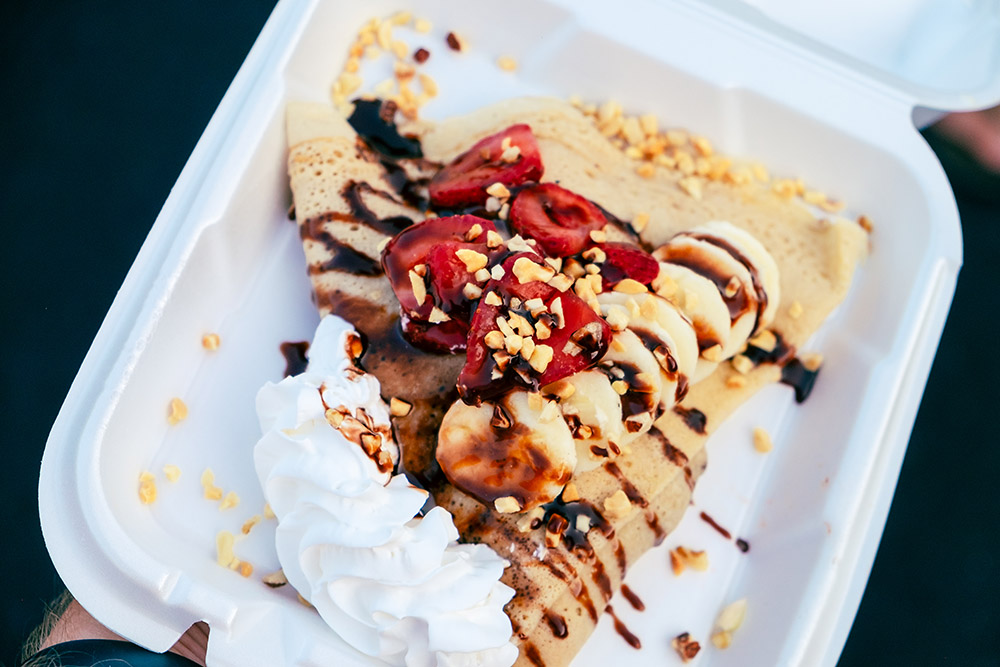
Banana and strawberry crepes sold for $3 a pop.
“Doing the Best We Can”
Darwin Hernandez spoke of self-regulation in July.
Recently, concerns from neighbors about sanitation, health, safety and violence permeated the area, and some vendors began to worry about their future.
Some local residents alleged in an email chain to Councilman Gil Cedillo and Mayor Eric Garcetti that the market was causing “violence,” vendors were being “extorted by gangs,” customers were parking “illegally,” and alcohol was being sold illegally.
Deputy District Director Jose Rodriguez said in an email that authorities closed the market to “eliminate illegal alcohol sales, public defecation and urination, and crime and violence that was caused by the market.”
Resident Auzelle Epeneter claimed in an email that police from the Hollenbeck Division told her that they had “recognized known gang members from other neighborhoods at the market.”
The Warehouse District Hot Spot
The Avenue 26 Night Market stretched down Artesian Street next to a furniture factory and a parking lot.
A group calling itself Respect Lincoln Heights said in the email chain that “our immediate neighborhood is overwhelmingly opposed to the dangers and unsanitary conditions it [the market] exposes us all to.”
Seth Polen, a commercial real estate advisor, even claimed he had tenants leaving the area because of the market.
Such complaints gained a sympathetic hearing on the pages of the Los Angeles Times.
On Aug. 3 influential columnist Steve Lopez wrote that the market created “a daily nightmare for residents and businesses.” He argued that it was undermining the quality of life for residents in the area and called for it to “be shut down immediately” until authorities find a way to regulate it.
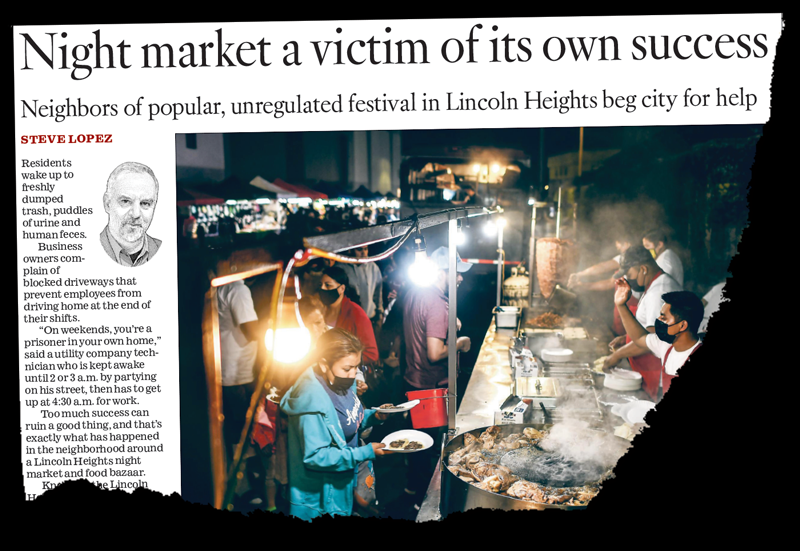
Two days after Los Angeles Times columnist Steve Lopez called for the market to be shut down, it was.
After the market closed, Huerta noted that undocumented vendors are sometimes victims of gangs and other criminals because they are afraid to go to the police or other authorities. He also said that the police and politicians instill fear in “vulnerable, informal petty entrepreneurs.” Once that fear is instilled, such people often have no one to turn to.
While the post-pandemic era promised renewal, it seems that the lessening of Covid restrictions by the city has made it more likely that authorities will push vulnerable people into the margins.
“No One in Charge”
Vendor David Vázquez talked about market arrangements in July.
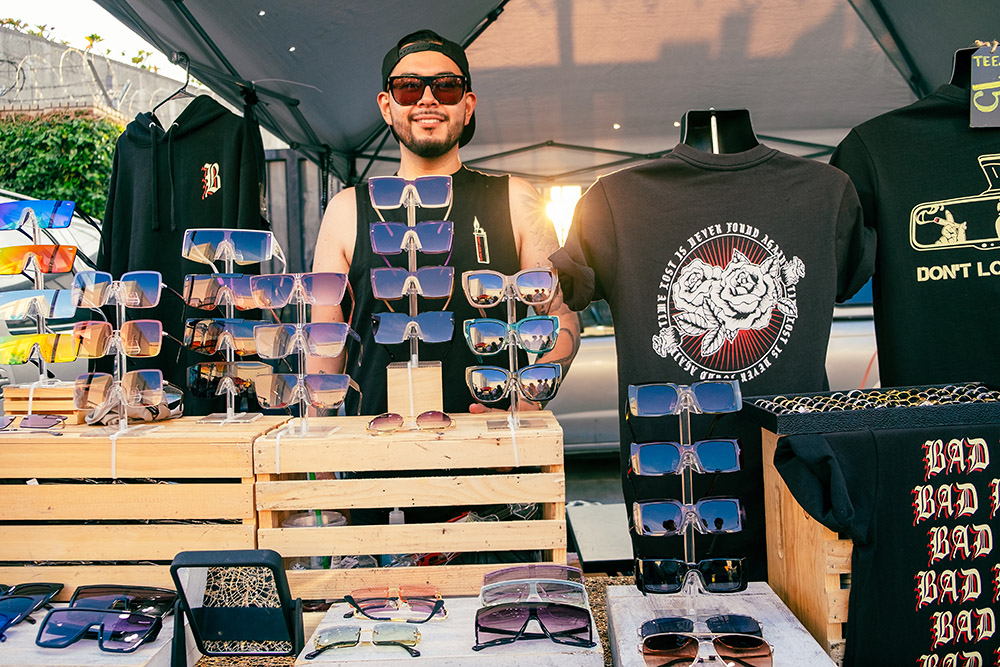
David Vázquez of Heart Owl sold clothes and jewelry at mall booths before the pandemic hit.
The Next Market?
Although the vendors saw their lives transformed by the market’s success, its closure will require them to evolve once again.
Analco and her family, like many of the market’s vendors, are waiting for the city to decide whether or not to allow the market to reopen and, if so, where and how, and at what cost?
For now, they are facing more immediate concerns. “We are full-time vendors, and Avenue 26 was my family’s only source of income to pay for rent, bills, food, basic necessities,” she said.
She pushed back against local residents’ claims that violence already existed in the area before the market began to flourish. “The community members saw this as an opportunity to blame the street vendors trying to make a living for the violence,” she said.
Dozens of vendors are trying to reverse the market’s closure. “We are protesting and hope that the city knows what they are doing to a large community,” Analco says.